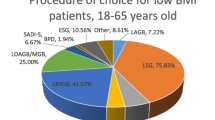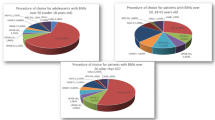Abstract
Introduction
The Asia-Pacific Metabolic and Bariatric Surgery Society (APMBSS) held its congress in Tokyo at the end of March, 2018, and representatives from Asia-Pacific countries presented the current status of bariatric/metabolic surgery in the “National Reports” session. The data are summarized here to show the current status and problems in the Asia-Pacific region in 2017.
Methods
A questionnaire including data of 2016 and 2017 and consisting of eight general questions was prepared and sent to representatives in 18 Asia-Pacific countries by e-mail before the congress. After the congress, the data were analyzed and summarized.
Results
Seventeen of 18 countries responded to the survey. The frequency of obesity (BMI ≥ 30) in the 4 Gulf countries was > 30%, much higher than that in the other countries. In total, 1640 surgeons and 869 institutions were engaging in bariatric/metabolic surgery. In many East and Southeast Asian countries, the indication for bariatric surgery was BMI ≥ 35 or ≥ 37, whereas in many Gulf countries and Australia, it was BMI ≥ 40 or ≥ 35 with obesity-related disease. Ten of the 17 countries (58.8%) but only one of the 5 Southeast Asian countries (20.0%) had public health insurance coverage for bariatric surgery. In 2017, 95,125 patients underwent bariatric/metabolic surgery, with sleeve gastrectomy accounting for 68.0%, bypass surgery for 19.5%, and others for 12.5%. Current problems included public insurance coverage, training system, national registry, and lack of awareness and comprehension.
Conclusion
This summary showed that bariatric/metabolic surgery is rapidly developing along with various problems in Asia-Pacific countries.

Similar content being viewed by others
References
Agrisani L, Santonicola A, Iovino P, et al. Bariatric surgery and endoluminal procedures: IFSO worldwide survey 2014. Obes Surg. 2017;27(9):2279–89. https://doi.org/10.1007/s11695-017-2666-x.
Buchwald H, Oien DM. Metabolic/bariatric surgery worldwide 2011. Obes Surg. 2013;23(4):427–36. https://doi.org/10.1007/s11695-012-0864-0.
Nimeri A, Al Hadad M, Khoursheed M, et al. The peri-operative bariatric surgery care in the Middle East region. Obes Surg. 2017;27(6):1543–7. https://doi.org/10.1007/s11695-016-2503-7.
Lee WJ, Wang W. Bariatric surgery: Asia-Pacific perspective. Obes Surg. 2005;15(6):751–7.
Prevalence of obesity among adults, BMI ≥ 30, age-standardized estimates by country, Global Health Observatory (GHO) data. World Health Organization homepage. http://apps.who.int/gho/data/node.main.A900A?lang=en.
Diabetes country profiles 2016, World Health Organization homepage. http://www.who.int/diabetes/country-profiles/en/.
Body mass index (BMI) distribution, Centre for Health Protection, Department of Health, the Government of the Hong Kong Special Administrative Region homepage. https://www.chp.gov.hk/en/statistics/data/10/280/6620.html.
Quan J, Li TK, Pang H, et al. Diabetes incidence and prevalence in Hong Kong, China during 2006–2014. Diabet Med. 2017;34(7):902–8. https://doi.org/10.1111/dme.13284.
Chang HC, Yang HC, Chang HY, et al. Morbid obesity in Taiwan: prevalence, tends, associated social demographics, and lifestyle factors. PLoS One. 2017;12(2):e0169577. https://doi.org/10.1371/journal.pone.0169577.
Diabetes and me, Health Promotion Administration, Ministry of Health and Welfare homepage. https://www.hpa.gov.tw/EngPages/Detail.aspx?nodeid=1067&pid=7181.
World Population 2017 Wallchart, United Nations homepage. https://esa.un.org/unpd/wpp/Publications/.
Percentage of total population by broad age group, both sexes (per 100 total population), United Nations homepage. https://esa.un.org/unpd/wpp/DataQuery/.
Buchwald H, Williams SE. Bariatric surgery worldwide 2003. Obes Surg. 2004;14(9):1157–64.
Buchwald H, Oien DM. Metabolic/bariatric surgery worldwide 2008. Obes Surg. 2009;19(12):1605–11. https://doi.org/10.1007/s11695-009-0014-5.
Agrisani L, Santonicola A, Iovino P, et al. Bariatric surgery worldwide 2013. Obes Surg. 2015;25(10):1822–32. https://doi.org/10.1007/s11695-015-1657-z.
Lomanto D, Lee WJ, Goel R, et al. Bariatric surgery in Asia in the last 5 years (2005–2009). Obes Surg. 2012;22(3):502–6. https://doi.org/10.1007/s11695-011-0547-2.
Martin LF, Tan T, Horn JR, et al. Comparison of the cost associated with medical and surgical treatment of obesity. Surgery. 1995;118(4):599–607.
Hoerger TJ, Zhang P, Segel JE, et al. Cost-effectiveness of bariatric surgery for severely obese adults with diabetes. Diabetes Care. 2010;33(9):1933–9. https://doi.org/10.2337/dc10-0554.
Song HJ, Kwon JW, Kim YJ, et al. Bariatric surgery for the treatment of severe obese patients in South Korea – is it cost effective? Obes Surg. 2013;23(12):2058–67. https://doi.org/10.1007/s11695-013-0971-6.
Tang Q, Sun Z, Zhang N, et al. Cost-effectiveness of bariatric surgery for type 2 diabetes mellitus. Randomized controlled trial in China. Medicine (Baltimore). 2016;95(20):e3522. https://doi.org/10.1097/MD.0000000000003522.
Lee YY, Veerman JL, Barendregt JJ. The cost-effectiveness of laparoscopic adjustable gastric banding in the morbidly obese adult population of Australia. PLoS One. 2013;8(5):e64965. https://doi.org/10.1371/journal.pone.0064965.
Rubino F, Nathan DM, Eckel RH, et al. Metabolic surgery in the treatment algorithm for type 2 diabetes: a joint statement by International Diabetes Organizations. Diabetes Care. 2016;39(6):861–77. https://doi.org/10.2337/dc16-0236.
Petrin C, Kahan S, Turner M, et al. Current practices of obesity pharmacotherapy, bariatric surgery referral and coding for counselling by healthcare professionals. Obes Sci Pract. 2016;2(3):266–71.
Matlok M, Pedziwiatr M, Major P, et al. The knowledge of Polish medical students about surgical treatment of obesity. Eur Surg. 2015;47(5):266–70.
Zacharoulis D, Bakalis V, Zachari E, et al. Current knowledge and perception of bariatric surgery among Greek doctors living in Thessaly. Asian J Endosc Surg. 2018;11(2):138–45. https://doi.org/10.1111/ases.12436.
Deurenberg P, Yap M, van Staveren WA. Body mass index and percent body fat: a meta analysis among different ethnic groups. Int J Obes Relat Metab Disord. 1998;22(12):1164–71.
Wong RJ, Chou C, Sinha SR, et al. Ethnic disparities in the association of body mass index with the risk of hypertension and diabetes. J Community Health. 2014;39(3):437–45. https://doi.org/10.1007/s10900-013-9792-8.
Misra A. Ethnic-specific criteria for classification of body mass index: a perspective for Asian Indians and American Diabetes Association position statement. Diabetes Technol Ther. 2015;17(9):667–71. https://doi.org/10.1089/dia.2015.0007.
Hsu WC, Araneto MRG, Kanaya AM, et al. BMI cut points to identify at-risk Asian Americans for type 2 diabetes screening. Diabetes Care. 2015;38(1):150–8. https://doi.org/10.2337/dc14-2391.
Acknowledgments
We thank Drs. Akira Sasaki and Takeshi Naitoh for the congress organization, Drs. Ken Loi, Sung Soo Park, Praveen Raj, Hiroshi Yamamoto, Susumu Inamine, and Takashi Oshiro for the program management, Dr. Nik Ritza Kosai for data management in Malaysia, and Dr. Kazuhiro Tada for manuscript assistance.
Author information
Authors and Affiliations
Corresponding author
Ethics declarations
Conflict of Interest
The authors declare that they have no conflict of interest.
Standard of Informed Consent
This is a survey in which there is no direct involvement with human subjects; it is limited to an analysis of population and bariatric/metabolic procedures in the Asia-Pacific region.
Rights and permissions
About this article
Cite this article
Ohta, M., Seki, Y., Wong, S.KH. et al. Bariatric/Metabolic Surgery in the Asia-Pacific Region: APMBSS 2018 Survey. OBES SURG 29, 534–541 (2019). https://doi.org/10.1007/s11695-018-3539-7
Published:
Issue Date:
DOI: https://doi.org/10.1007/s11695-018-3539-7




